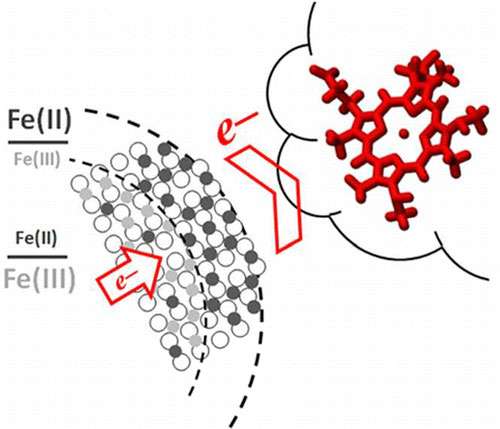Aquatic microbe oxidizes iron minerals from the surface inward

(Phys.org) —When the water-dwelling microbe Sideroxydans lithotrophicus ES-1 connects with iron mineral particulates, three microbial proteins quickly extract electrons from divalent iron or Fe(II), leaving behind trivalent iron, according Pacific Northwest National Laboratory and Lawrence Berkeley National Laboratory scientists. The oxidation reaction begins when the protein contacts the particle's surface and continues into the particle interior, without damaging the iron lattice. The electron transfer is faster if the particle starts with a high ratio of Fe(II) to Fe(III).
"Using a new experimental strategy of probing iron nanoparticles interacting with pure protein, we proved that proteins can efficiently oxidize the iron in the interior without changing the structure," said Dr. Juan Liu, a PNNL geochemist who led the year-long study. "Before, we didn't have the tools and methods to directly investigate Fe(II) minerals and their interactions with proteins. Now, we do."
Iron is continually transformed by microbes in the subsurface environment. Soluble Fe(II), which travels through the groundwater, can become Fe(III), which remains relatively stationary. By understanding how the microorganisms accelerate or control iron's changes, scientists better understand how microbial activity is linked to iron cycling in the environment. This understanding also helps shed light onto processes coupled to the iron cycle, such as cycling of carbon, nitrogen, sulfur, and other metals. For example, this connection could be important for predicting how subsurface biogeochemistry contributes to carbon exchange with near-surface environments, with impacts on processes that influence food availability, water resources, and extreme weather patterns.
"We know from the nature of what these organisms do that the iron cycle is linked with the carbon cycle, but much remains to be learned," said Dr. Kevin Rosso, manager of PNNL's Geochemistry Group, and a researcher on the project. "With this study, we are attempting to tease apart some of the details of a process that is part of this linkage, so we can learn the extent to which these processes may be important at larger scales."
The team took a new approach by reducing a complex heterogeneous system to its molecular components, to isolate the electron transfer reactions that underpin the microbial oxidation activity. They analyzed the reaction as it occurred on particle surfaces, and protein and end products in instruments at the Environmental Molecular Sciences Laboratory and the Advanced Light Source.
They purified MtoA, a key decaheme c-type cytochrome involved iron oxidation by the Gram-negative Sideroxydans lithotrophicus ES-1. They synthesized 10-nanometer-wide Fe3-xTixO4 particles, a nanoparticle system developed at PNNL containing iron, titanium, and oxygen. By varying the amount of titanium in the particles, the team tuned the Fe(II)/Fe(III) ratio, essentially controlling the amount of oxidation that could occur in the particle.
The team used the stopped-flow technique under anaerobic conditions in real time and measured the absorbance of protein in the solution. A key challenge was working with the extremely small samples of both the proteins and the particles. By monitoring the protein absorbance changes, they calculated the kinetics of the electron transfer reaction with the particles.
They took samples of the nanoparticles before and after exposure to MtoA and measured the iron ratio with micro-X-ray diffraction at EMSL. They also examined changes in the Fe(II)/Fe(III) ratio and magnetic properties at the nanoparticle-cytochrome interface using X-ray absorption and magnetic circular dichroism spectroscopies with synchrotron resources at the Advanced Light Source. The data showed that the higher the Fe(II)/Fe(III) ratio, the greater the electron transfer kinetics to the protein.
"Previously, we studied oxidation in solution-a homogenous study. Now, we have created a method to allow us to study in a heterogeneous system," said Liu.
The researchers are now purifying the electron-transfer membrane proteins from other microbes, including Geobacter and Shewanella, to determine how the proteins will reduce or oxidize iron. The results will ultimately lead to a better understanding of subsurface reactions in the biogeochemical iron cycle. In addition, the new method that uses extremely small protein quantities and nanoparticles with powerful experimental equipment can be used to investigate other bacterial proteins and iron-containing minerals.
More information: Liu, J. et al. 2013. Fe3-xTixO4 Nanoparticles as Tunable Probes of Microbial Metal Oxidation, Journal of the American Chemical Society 135 (24), 8896-8907. DOI: 10.1021/ja4015343
Journal information: Journal of the American Chemical Society
Provided by Pacific Northwest National Laboratory




















